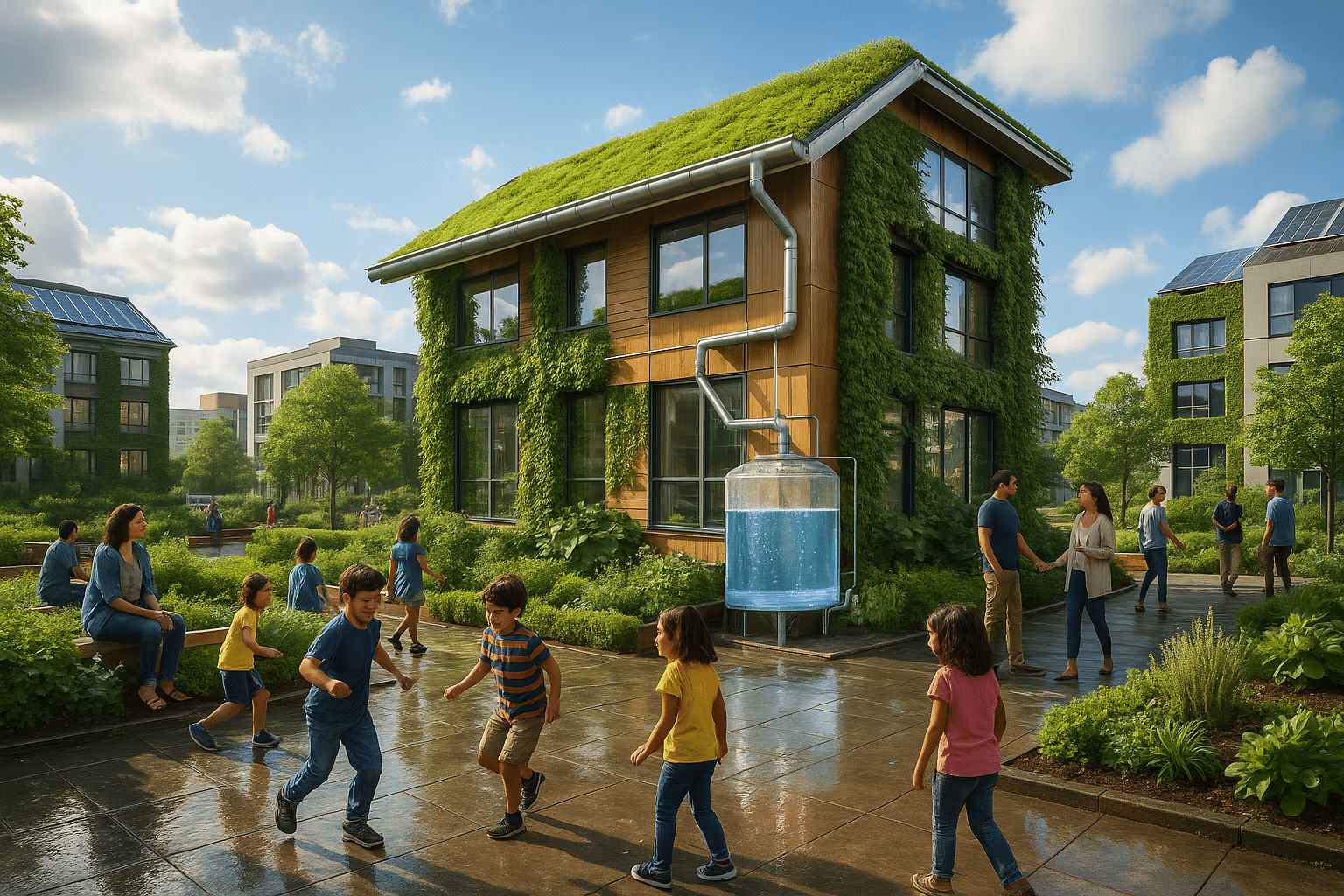Notwithstanding, the quest for a sustainable solution has never been more urgent. Enter: Rainwater harvesting, an ancient practice with a modern twist, being dusted off and refined for the 21st century. A radical revolution indeed! In this piece, we will delve into the mechanics of rainwater harvesting, its environmental and economic benefits, and how it could just be the game-changer we need to safeguard our tomorrow. 🌍💧
But first, let’s set the stage: Water scarcity is no longer a distant threat; it’s a present reality for billions. By 2025, the World Bank estimates that two-thirds of the global population could be living under water-stressed conditions. Amid this scenario, relying solely on traditional water supply systems seems more like a doomed strategy. The silver lining? We live on a planet where nearly 397,000 cubic kilometers of rain fall annually. The challenge? To capture and utilize this bounty effectively and sustainably. The solution? Rainwater harvesting.
The Promise of Rainwater Harvesting
Rainwater harvesting isn’t just about collecting rain. It’s about creating a sustainable and resilient system that integrates seamlessly into our urban landscapes and rural countrysides. It’s about encouraging a culture of water conservation and educating people about the importance of every drop. More importantly, it’s about empowering communities with a reliable and local water source, mitigating the impacts of climate change, and creating a sustainable future. 🌧️
Demystifying the Process
So, how does rainwater harvesting work, you might wonder? We’ll delve into the nitty-gritty, exploring how a system is designed, implemented, and managed, and how the harvested rainwater can be utilized in the most efficient manner. From catchment areas to conveyance systems and storage tanks, we’ll break down the entire process in easy-to-understand terms, turning the complex into comprehensible. 🧠👩🔧
Economic and Environmental Benefits
But the story of rainwater harvesting isn’t just about the technicalities. It’s also about the potential benefits, both economic and environmental. Reduced reliance on municipal water supply, decreased water bills, improved groundwater levels, diminished flood risks, and lower carbon footprint — the list is long and impressive. We’ll walk you through each benefit, backing up our assertions with relevant data and real-world examples. 🌳💰
Bringing the Rainwater Revolution to Your Doorstep
The big question: How can you become a part of this revolution? Here, we will provide you with practical tips and tricks on implementing a rainwater harvesting system at your home or community. We’ll discuss the potential hurdles you might face and offer solutions to overcome them. We’ll also highlight some of the latest innovations and trends in the field, giving you a glimpse into the future of water sustainability. 💡
Ready to dive into the fascinating world of rainwater harvesting? The journey promises to be enlightening, engaging, and above all, empowering. After all, every revolution begins with a single step, and your step towards embracing rainwater harvesting could be a leap for mankind’s sustainable future. Let’s embark on this journey together, one drop at a time! 💧🚀
Tap into Nature’s Reservoir: Unveiling the Potential of Rainwater Harvesting
💧Water is a necessity for life. Yet, many parts of the world experience severe water shortages. However, there’s a silver lining to this grim reality – rainwater harvesting. This sustainable solution has been around for centuries, but the ever-increasing demand for water has brought it back into the spotlight. So, what is rainwater harvesting, and how can it help us save tomorrow? Let’s dive in.
Rainwater harvesting is the collection and storage of rainwater for later use. This practice can significantly reduce our reliance on traditional water supplies, reduce water bills, and provide a sustainable water source during dry periods. Moreover, rainwater is a high-quality water source, free from chemicals, making it ideal for irrigation, washing, and even drinking after proper treatment.
Several methods of rainwater harvesting exist, each with its own set of advantages and disadvantages. The most common methods include rooftop harvesting, surface runoff harvesting, and recharge to groundwater. Understanding the pros and cons of each method is crucial to making an informed decision about which one to use. The table below provides a comparison of these methods.
| Method | Advantages | Disadvantages |
|---|---|---|
| Rooftop Harvesting | Easy to install, low cost, high quality water | Limited collection area, potential contamination from roofing materials |
| Surface Runoff Harvesting | High collection potential, can be used for large scale irrigation | Requires large storage area, potential contamination from surface pollutants |
| Recharge to Groundwater | Replenishes groundwater sources, minimal storage requirements | Requires specialized installation, potential contamination if not properly filtered |
For a more detailed explanation of these methods, check out this informative video: “Rainwater Harvesting Methods and Techniques” by the Green Energy Futures channel on YouTube.
Harvesting Rain, Building the Future: The Role of Technology
👩💻While traditional methods of rainwater harvesting remain effective, advancements in technology have enabled more efficient and comprehensive systems. From automated collection and filtration systems to IoT-enabled monitoring solutions, technology is revolutionizing the way we collect, store, and use rainwater.
Automated rainwater harvesting systems utilize sensors and microcontrollers to maximize water collection and minimize water waste. These systems can automatically switch between rainwater and traditional water supplies based on the availability of stored rainwater. Furthermore, advanced filtration systems can purify harvested rainwater, making it suitable for drinking and other domestic uses.
IoT-enabled rainwater harvesting systems provide real-time monitoring of water levels, quality, and usage patterns. They can provide valuable insights, allowing users to optimize their water use and ensure a constant supply. Moreover, these systems can send alerts when maintenance is required, ensuring the longevity and effectiveness of the rainwater harvesting system.
For a sneak peek into how technology is transforming rainwater harvesting, watch the video “The Future of Rainwater Harvesting” by Tech Insider.
Saving Tomorrow: The Environmental and Economic Benefits of Rainwater Harvesting
🌍Rainwater harvesting is not just about securing a sustainable water supply; it’s about creating a better and more sustainable future. By reducing our reliance on traditional water supplies, we can alleviate the pressure on these resources, leading to a more balanced and sustainable water cycle.
Furthermore, rainwater harvesting has significant economic benefits. It can reduce water bills, provide a reliable water supply during dry periods, and increase property value. Moreover, with the integration of advanced technologies, the efficiency and usability of harvested rainwater can be maximized, leading to further savings.
Finally, rainwater harvesting can play a vital role in urban environments, where impervious surfaces often lead to water runoff and flooding. By collecting and using rainwater, we can reduce runoff, mitigate flooding, and contribute to a more sustainable urban landscape.
To gain a deeper understanding of the environmental and economic benefits of rainwater harvesting, consider watching the video “Why Rainwater Harvesting is the Future of Water Conservation” by Watercache.
Seize the Rain: Getting Started with Rainwater Harvesting
☔Starting your journey into rainwater harvesting can seem daunting. However, with the right information and tools, it can be a straightforward and rewarding process. Here’s a quick step-by-step guide on how to get started with rainwater harvesting.
- Step 1: Assess your needs. How much water do you use daily? What will you use the harvested rainwater for?
- Step 2: Analyze your catchment area. How much rainwater can you realistically collect?
- Step 3: Choose a suitable harvesting method. Refer back to our comparison table to help you decide.
- Step 4: Install your rainwater harvesting system. This can be a DIY project or done by a professional.
- Step 5: Monitor and maintain your system. Regular maintenance is crucial to ensure its longevity and effectiveness.
Embarking on the rainwater revolution can not only secure a sustainable water supply for yourself but also contribute to a more sustainable and resilient future. So why wait? Start harvesting rain and saving tomorrow today!
For a practical guide on setting up a rainwater harvesting system at home, tune into the video “DIY Rainwater Harvesting System” by Practical Preppers.

Conclusion
In summary, this detailed exploration into the intricacies of Information Technology and Engineering underscores the remarkable depth and breadth of both fields. We’ve touched on the fundamental aspects of software engineering, from its principles and practices, to its real-world applications and challenges. As a reminder, it’s crucial to stay updated with the latest trends, keeping an eye on the rapid technological advancements that continue to reshape our understanding and application of software engineering.
Remember, the essence of software engineering lies in its ability to simplify complex tasks and streamline processes, making our lives significantly more convenient. With a proper understanding of its principles and techniques, we can create software that’s not only functional but also user-friendly and efficient.
Furthermore, we’ve also delved into the captivating world of IT, exploring its numerous facets ranging from data management and cybersecurity to cloud computing and AI. IT is a dynamic field that’s continually evolving, making it imperative to stay abreast with the latest developments. Just as we emphasized earlier, being proficient in IT doesn’t just boost your career prospects, but it also equips you with the skills needed to navigate our increasingly digital world.
It’s impossible to overstate the importance of these fields in our current digital age. They’re integral to almost every sector, from healthcare and education to finance and entertainment.
If you’ve found this article helpful and enlightening, please feel free to share it with others who might also benefit from it. Your shares and comments help us reach a wider audience and inspire us to continue creating content that’s both informative and engaging.
Moreover, if you’ve got any queries or suggestions, we encourage you to voice them out in the comment section. We’re always eager to hear from our readers and to engage in insightful discussions.
We hope that this article has piqued your interest and inspired you to delve deeper into these intriguing fields. Remember, knowledge is power, and the more you learn, the more equipped you’ll be to make a meaningful contribution to society.
So, continue to pursue knowledge, remain curious, and don’t hesitate to embrace new challenges. The world of technology is vast and full of opportunities, waiting for you to seize them.
To dig deeper into software engineering and IT, you might find these resources helpful:
- IEEE Computer Society – Software Engineering 🔗
- ACM SIGSOFT – Software Engineering 🔗
- IEEE Computer Society – Information Technology 🔗
If you found this article helpful, please consider sharing it on your favorite social media platform. It helps us a lot! 🚀🙏
To stay updated on our latest articles, you can subscribe to our newsletter or follow us on our social media channels.
Stay curious, and keep learning! 💡🎓
Article References:
- IEEE – Principles of Software Engineering
- ACM Digital Library – IT and Cybersecurity
[newsletter_signup_form id=1]



